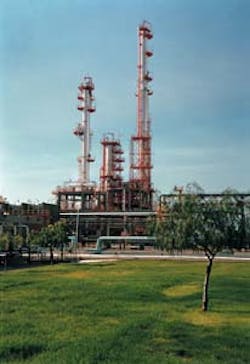Argentine refinery becomes an unleaded gasoline exporter
YPF used to make lead in a building on this lawn until the HF alkylation unit in the background made leaded gasoline obsolete.In 1996, Yacimentos Petroliferos Fiscales SA (YPF) invested nearly $30 million in its Lujan de Cuyo, Mendoza, Argentina, refinery to build an isomerization and an alkylation unit.
The Hydrisom and hydrofluoric acid (HF) alkylation processes, licensed by Phillips Petroleum Co., make the Lujan de Cuyo refinery an exporter of unleaded gasoline.
According to YPF, its Lujan de Cuyo refinery has a processing capacity of 120,000 b/cd, the second largest of three YPF refineries in Argentina. Because of the refinery's proximity to significant YPF distribution terminals, the refinery is a primary domestic supplier to regions distant from Mendoza.
Environmental projects
The Lujan de Cuyo refinery is located in a semiarid region of western Argentina. Due to limited rainfall, irrigation is important to this farming and wine-producing area.YPF addressed water concerns by running a closed coolant system to clean and recycle most of the water that the refinery uses to cool its process units. Water quality is measured daily at the treatment center, and groundwater is monitored at two test wells that are on-site.
The new alkylation plant at the Lujan de Cuyo refinery is the only one in YPF's refinery system. The gasoline output now meets international standards; octane levels are increased, and benzene and aromatics are significantly reduced.
Hydrisom process
YPF uses Phillips' Hydrisom process ( Fig. 1 [31,597 bytes]) to upgrade C4 olefins by selective diolefin hydrogenation and isomerization, thus producing enhanced feedstock for the HF alkylation unit.The Hydrisom unit selectively hydrogenates butadiene to butene-1 and isomerizes butene-1 to butene-2. Butene-2 is the preferred olefin because it produces alkylate with a higher octane number.
Removing butadiene from the alkylation unit feed reduces acid soluble oil (ASO) production, preserving HF catalyst purity and reducing acid consumption.
Alkylation process
YPF's Lujan de Cuyo refinery produces 63,000 b/d of unleaded gasoline. The Hydrisom unit started up in December 1996, and the HF alkylation unit began operations in January 1997. Each unit has a capacity of 2,500 b/d.The alkylation unit uses the differential gravity between the HF and the hydrocarbons to generate circulation without using pumps (Fig. 2 [35,470 bytes]).
This design eliminates maintenance-intensive pumps and stirrers, and avoids the high operating pressures required to move the acid catalyst. The only pump moving concentrated HF is the one feeding the acid regenerator circuit.
Safety features
The new HF alkylation unit includes several safety considerations: inventory management process, personnel training, and remote controls.The Phillips inventory management process (IMP) includes a rapid acid transfer system to quickly empty the unit in case of a leak.
The acid coolers and the alkylation reactor/settler are positioned above the storage tank. If a release occurs, the entire acid and hydrocarbon contents in the reactor settler can be dumped into the storage vessel in 5-8 min. The use of gravity to empty the reactor/settler into a secure storage vessel allows the transfer to occur even during a power failure.
YPF managers, engineers, and operators visited the U.S. and Spain to observe crews at other alkylation units.
Remote operations help ensure personnel safety at the unit. Operators monitor and control the alkylation unit using computerized process controls from a positively pressured control room.
Remote-controlled water cannons are set at four key locations around the unit (Fig. 3 [20,700 bytes]), and fixed water sprays are directed at specific vessels. With remote television cameras, the cannons can be controlled and monitored from the control room during the unlikely event of an HF vapor release.
Octane number
Before the Hydrisom and alkylation units came on-line, YPF imported alkylate to meet specifications for domestic unleaded gasoline production. Including revamps to its La Plata refinery, near Buenos Aires, YPF has a combined capacity of 300,000 b/d, which allows it to become an exporter. YPF sells 85-90% of its finished petroleum products to the domestic market. More than 75% of the exports go to other Latin American countries.Since October 1993, YPF produced only unleaded motor gasoline. At that time, it also started to add methyl tertiary butyl ether (MTBE) to its fuels to reduce smog. YPF demolished its lead additive plant when the new HF alkylation plant came on-line in 1997.
The octane-boosting properties of the alkylate are important to Lujan de Cuyo. Argentine regulations require that the company meet gasoline research and motor octane numbers (RON and MON). YPF produces its mid-grade gasoline, called super, at 95 RON, and its premium-grade gasoline, called ultra, at 97 RON. The normal-grade gasoline (87 RON) never needed alkylate because the refinery catalytic cracking unit was able to produce a straight-run gasoline of 93-94 RON.
The new HF alkylation unit also allows Argentina to be self-sufficient in producing 100 octane low-lead aviation gasoline. Although YPF imports the lead needed for the aviation piston engines, it still uses the alkylate to increase octane to 100.
The low endpoint in the refinery's new fractionation tower is ideal for producing YPF aviation gasoline. While other refineries would need another fractionator to make enough low-lead aviation gasoline, the Lujan de Cuyo refinery can produce all the aviation gasoline needed for the region's small aviation market in 2-3 days each month.
Future markets
YPF is working to improve its international position. It is expanding and strengthening its export positions with joint ventures in Texas, Indonesia, Ecuador, and Venezuela.The company has branded gasoline stations in Argentina, Chile, Peru, and Uruguay. It is working with Petrobras on projects in Brazil. The Mercosur agreement, a trade pact among Argentina, Brazil, Uruguay, and Paraguay, is important to YPF because Brazil imports 40% of the petroleum products it consumes.
Copyright 1998 Oil & Gas Journal. All Rights Reserved.
